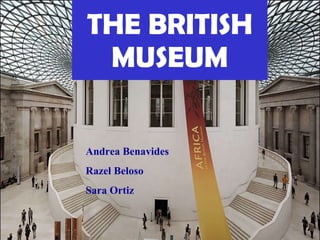
The British Museum
- 1. THE BRITISH MUSEUM Andrea Benavides Razel Beloso Sara Ortiz
- 2. The eighteenth century: The origins of the British Museum started with the naturalist and collector, Sir Hans Sloane (1660–1753). Sloane collected more than 71,000 objects which he wanted to be preserved intact after his death. The founding collections largely consisted of books, manuscripts and natural specimens with some antiquities. The British Museum opened to the public on 15 th of January 1759. It was first situated in the seventeenth-century mansion, Montagu House in Bloomsbury. Even though there were the two World Wars, this museum was still open and increasing it’s oppening hours as well as the attendance in increased from 5000 people to 6 million.
- 3. The nineteenth century: In this century, the museum received the Rosetta Stone in the year 1802, the Townley collection of classical sculpture in the year 1805, and the Parthenon sculptures in the year 1816. In 1857, both the quadrangular building and the round Reading Room had been constructed. A key figure during this period was Sir Augustus Wollaston Franks (1826–97). He was the first person to be responsible for British and medieval material. Franks expanded the collection in new directions, by collecting prehistoric, ethnographic and archaeological material from Europe and beyond as well as oriental art and objects.
- 4. Since the twentieth century until now, this museum has been open to the public. And the people that visit it can see the different sections about the history.
- 5. Double-headed serpent turquoise mosaic . AMERICA`S SECTION In the America’s section we can find the Double-headed serpent turquoise mosaic. It was built in the 15 th -16 th centuries AD in Mexico. It was amongst the goods given to the adventurer Hernando Cortez.
- 6. The rosetta stone Jean François Champollion found Rosetta stone in 15th of July 1799. Rosetta stone is composed of granite. The Rosetta stone was written in three languages: H ieroglyphic, D emotic and G reek. ANCIENTE EGYPT SECTION
- 7. MIDDLE EAST SECTION This alabaster panel was part of a series which decorated the walls of a room in the palace of King Sennacherib (reigned 704-681 BC). It tells the story of the siege and capture of the city of Lachish in 701 BC Lachish relief
- 8. AFRICA SECTION Kilwa pot sherds Kilwa Kisiwani, Tanzania, about AD 1000 to 1500. They were found at the town of Kilwa Kisiwani, and are some of the rubbish thrown away by its inhabitants. Between 1000 and 1500 AD Kilwa was an important port on the Indian Ocean. These broken pieces of pottery provide evidence of the places it traded with. Some of the other green and decorated pieces of pottery were made in the Middle East, perhaps in Iran or Oman.
- 9. GREECE AND ROME SECTION Parthenon sculpture This sculpture is from the famous temple on the Acropolis in Athens. It shows a mythological battle between a human Lapith and a barbaric centaur. It was made in Acropilis, Athens, Greece around 440 BC. The Parthenon featured 92 sculptures known as metopes. They were located on all four sides of the temple. Those from the south side of the building include this one, which is part of a series featuring Lapiths in combat with centaurs. Lapiths were humans from northern Greece, while centaurs were part-man and part-horse, that represent the dual aspect of their nature. They were capable of being both civilised and savage .
- 10. ASIA SECTION It is from China in the Shang dynasty, about 1500-1050 BC. It is inscribed by the Qianlong emperor in 1790. Inscribed with a poetic reflection on the object by the Qianlong emperor. The Qianlong emperor was a great collector of antiquities. He managed to acquire many famous old paintings, bronzes, porcelains and jades for the imperial collection. This policy led some connoisseurs to commission copies of their prized paintings, so they would not lose the originals to the emperor. Jade bi
- 11. THE END!